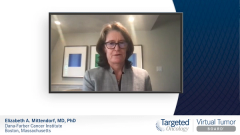
Case 3: Implications of Residual Disease on TNBC Outcomes
Pathologist David G. Hicks, MD, discusses the impact of residual disease in breast cancer treatment outcomes.
Episodes in this series

Elizabeth A. Mittendorf, MD, PhD: I want to go back to the top of this case. David, this is another example from this evening’s discussion in which a patient received neoadjuvant chemotherapy and then had residual disease. Can you talk to us a little about some of the path considerations and how you evaluate the breast tissue and the lymph nodes in a patient who’s received neoadjuvant chemotherapy? Could you maybe speak a little about residual cancer burden?
David G. Hicks, MD: Sure. It’s important to know that the patient has had neoadjuvant therapy before we start to examine the specimen. I have to admit, they don’t always tell us that. One of our practices is to read the operation note and the clinical notes on every lumpectomy or mastectomy, just so we have a better sense. We also like to know, if it’s a mastectomy, where in the breast tissue the lesion was. Oftentimes we’ll be looking at the history and the imaging.
When we examine the breast tissue, we want to look for a tumor bed. About 30% to 40% of the time with a complete pathologic response, we won’t find any growth tumor left behind in the breast tissue. But oftentimes we can see this fibrous area that the tumor occupied before the treatment. We need to measure that area and give an estimation of that. We also completely examine all lymphoid tissue that’s submitted. We often submit the entire tumor bed sequentially. For years, we’ve used the residual cancer burden [RCB] score using the algorithm from The University of Texas MD Anderson Cancer Center in Houston, Texas, which was quite powerful in predicting survival. That’s true for triple-negative and other breast cancer subtypes: where you’re putting in information about the tumor bed, the cellularity of invasive tumor, the percentage of the tumor that’s DCIS [ductal carcinoma in situ], and then the lymph nodes. It turns out, having a residual disease in the lymph nodes is much more heavily weighted because it’s based on the prognosis. If it’s a complete pathologic response, which means there isn’t a residual tumor in the breast tissue and in the lymph nodes, it’s a PCR [polymerase chain reaction]. That’s good news.
The T [tumor] staging is a little tricky because in primary breast cancers that haven’t had neoadjuvant therapy, we might calculate the size. But in patients with minimal residual disease, what you tend to see are little bits of tumor here and there across the tumor bed. You don’t want to calculate that. It’s going to grossly overestimate how much tumor is left behind. The rule is to find the largest confluent area of tumor on a slide and measure that for the T stage. It’s fairly easy to do. It takes a couple of extra steps. We enter the data on the MD Anderson website, and it calculates a residual cancer burden score and class. It’s very helpful to the breast surgeons but maybe more so to the medical oncologists.
Elizabeth A. Mittendorf, MD, PhD: The work you’re referring to, the RCB, was championed by William Fraser Symmans. I had the privilege of calling Fraser a colleague when I was at MD Anderson. It’s notable that in patients who experienced a pathologic complete response and no residual invasive disease in the breast tissue or lymphomas, receive a score called an RCB 0. Their prognosis is outstanding. It actually doesn’t look that different from patients with hormone receptor–positive breast cancer.
Transcript edited for clarity.












































